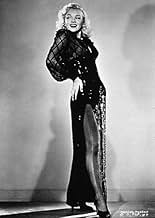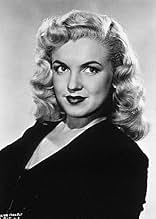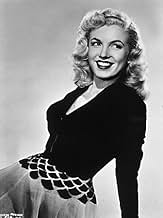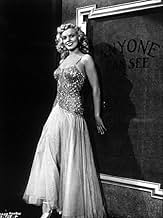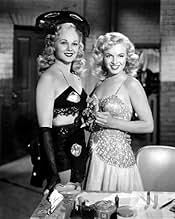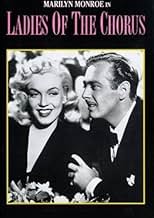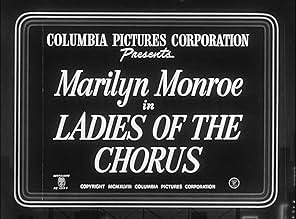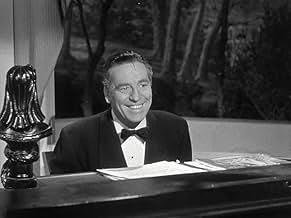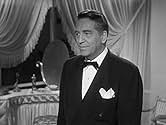Ajouter une intrigue dans votre langueA chorus girl falls in love with a wealthy young man, but their relationship is jeopardized by her mother's fears about the reaction of his family.A chorus girl falls in love with a wealthy young man, but their relationship is jeopardized by her mother's fears about the reaction of his family.A chorus girl falls in love with a wealthy young man, but their relationship is jeopardized by her mother's fears about the reaction of his family.
- Réalisation
- Scénario
- Casting principal
- Ripple the Decorator
- (non crédité)
- Flower Shop Girl
- (non crédité)
- Audience Member
- (non crédité)
- Mr. Craig - Stage Doorman
- (non crédité)
- Peter Winthrop
- (non crédité)
- Party Guest
- (non crédité)
- Party Guest
- (non crédité)
- Party Guest
- (non crédité)
- Alan Wakely - Mae's Ex-husband
- (non crédité)
- Party Guest
- (non crédité)
- Burlesque Show Spectator
- (non crédité)
Avis à la une
There is a good segment where Adele Jurgens (Mae) shows off some dance moves – probably the best moment of the film. The music is OK, Marilyn Monroe sings a couple of songs, but nothing too special.
The flimsy story wraps itself up over the course of an hour, but we watch it for Marilyn Monroe.
Marilyn stars as Peggy, a very young burlesque chorus girl who works in the chorus alongside her fortyish mother Mae (Adele Jergens). When the obnoxious "star" of the show walks out, Peggy steps into her part and becomes a sensation, earning the interest of various back door johnnies, in particular wealthy heir Randy (Rand Brooks). Peggy and Randy fall in love and he proposes but Mae is wary that Peggy will never be accepted in his social circles from her own past experience with her own annulled marriage to a socially prominent young man decades ago. Mae makes Randy promise to tell his mother (Nana Bryant) that Peggy is a burlesque queen in advance of their visit to the family's Cleveland estate, which he fails to do.
Marilyn is just adorable in this film and sings two surprisingly good songs for a "B" movie, "Anyone Can See I Love You" and "Every Baby Needs a Da Da Daddy", the latter a sexy little number that foreshadows her classic "Diamonds are a Girl's Best Friend" in sexiness and philosophy, right down to a reference to Tiffanys. Columbia's resident B queen of the era Adele Jergens is negated to a subordinate role as her mother, as still shapely middle-aged dancer who hides her gray hair under a blonde wig. Adele does very well at suggesting a slightly tired woman a decade or so older than her actual age and also gives a very good performance. (Adele was top billed in the original 1948 release but it appears only copies from the 1952 reissue exist where Marilyn was given that spot).
Rand Brooks (best known as Scarlett O'Hara's first husband in GONE WITH THE WIND) is quite pleasant as Marilyn's romantic suitor (they have a lovely scene together parked in a car that is an endearing ode to wholesome young love) and character actress Nana Bryant gives a pleasant performance as his mother, complete with a musical number of her own, the memorable "You're Never Too Old". Standing out in good comic unbilled bits are Gladys Blake as a gossipy sales girl and Dave Barry as a garbled-speaking decorator.
Running just a minute over an hour, the movie moves so quickly there's really no time for dull spots. This movie was reissued in 1952 by Columbia at the dawn of Marilyn's stardom but was virtually unseen for decades thereafter (likely because it was too short for most television movie programming slots); it reemerged in 1994 on video and a few years later had a handful of showings on cable television. Today your best bet in seeing it would probably be in buying a used copy of the out-of-print VHS tape or, if your DVD player can handle it, the region 2 DVD release from the United Kingdom in a Marilyn Monroe boxed set.
Monroe's sweet singing voice is showcased for the first time in this film, and it is a real treat. She had not yet adopted the "Marilyn Monroe" persona, but even without the breathy baby-doll voice she is the image of innocent seduction.
Although the plot is rather formulaic and simplistic, this film does offer something of a twist at the end. All in all a cute film and opportunity to see Monroe as a young fresh-faced beauty who, as always, lights up the screen.
Sure, her performance wasn't going to win an Oscar but she is self-assured and natural in front of the camera. Leaving aside a couple of duff line deliveries Monroe sparkles in this movie and brightens it up somewhat.
Although relatively light-weight and inconsequential, this cheapo is actually pretty well produced and looks and feels of higher quality than most quickie filler films.
At the end of the day, this is really going to appeal only to fans of Marilyn Monroe wanting to see her in an early role, but is enjoyable nevertheless and a pleasant way to waste an hour.
Le saviez-vous
- AnecdotesWhen the film was re-released in November 1952, Columbia redesigned the opening title credits with the name of Marilyn Monroe over the title, and the name of Adele Jergens, who originally had top billing, moved to the head of the supporting cast; this is the version that was shown on Turner Classic Movies.
- GaffesIn a flashback that takes place more than twenty years earlier, the women's hairstyles and clothes are those of 1948.
- Citations
Chorus Girl #3: He says to me, "I'd like to see your show, baby, how about a couple of passes?"
Chorus Girl #2: The nerve!
Chorus Girl #1: And the guys I go out with don't want passes. They just make 'em.
Chorus Girl #3: Speaking of passes, I've been knocking down so many lately, I feel like an All-American.
- ConnexionsEdited into Okinawa (1952)
Meilleurs choix
- How long is Ladies of the Chorus?Alimenté par Alexa
Détails
- Date de sortie
- Pays d’origine
- Langue
- Aussi connu sous le nom de
- Ladies of the Chorus
- Lieux de tournage
- Société de production
- Voir plus de crédits d'entreprise sur IMDbPro
- Durée1 heure 1 minute
- Couleur
- Rapport de forme
- 1.37 : 1
Contribuer à cette page


